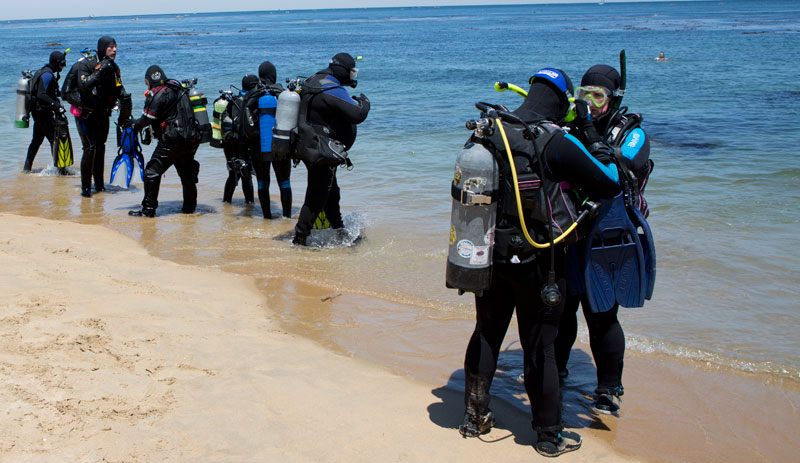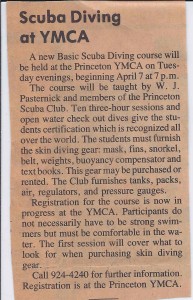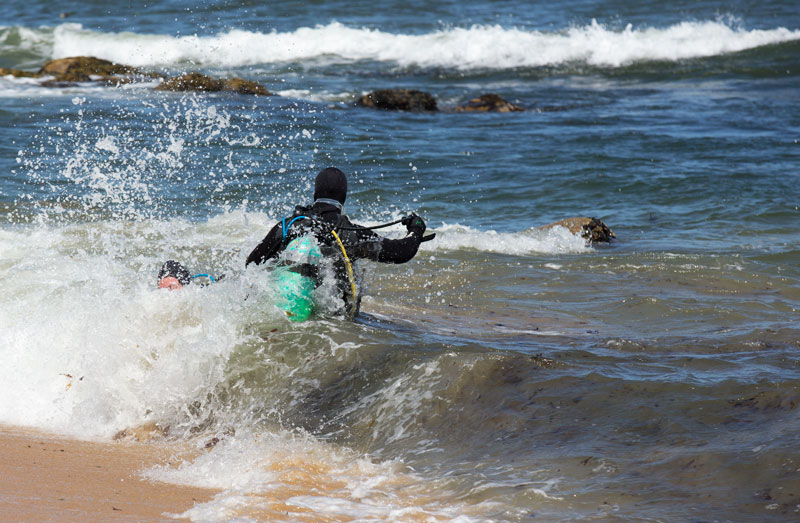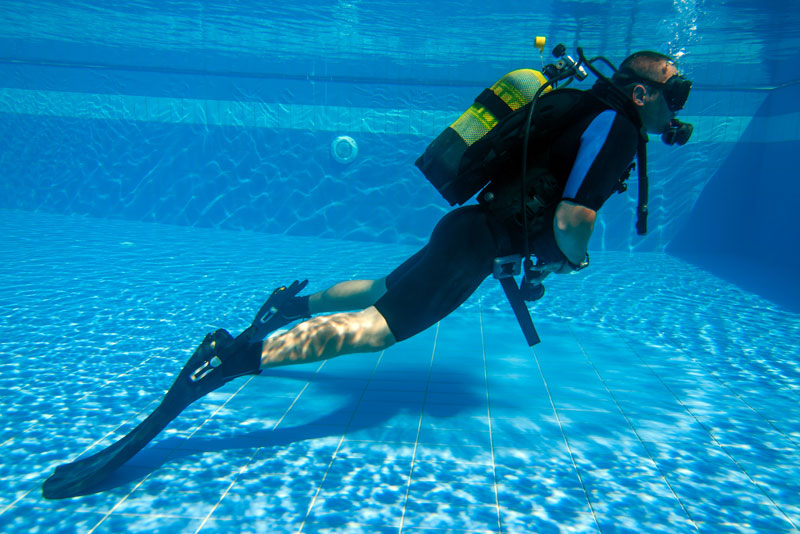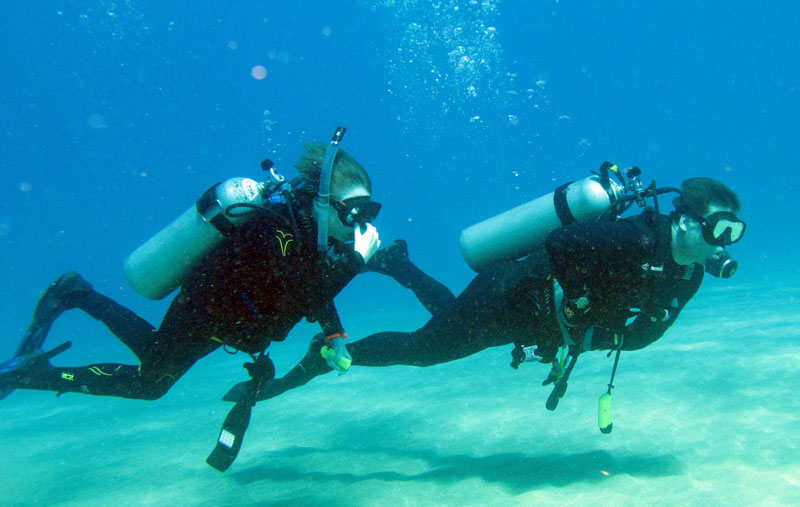There’s no question that scuba diving instruction has changed dramatically from the early days of diving. Dive gear and technology have certainly changed, and along with it, methods of training and education have also been refined, making both teaching and learning new concepts easier and more efficient.
 Certainly the physical component of learning to dive has changed dramatically. Dive courses in the 1960s, for example, had a very strong exercise component, often resembling military training. Thankfully, we don’t need to do 100 push ups in full dive gear, swim for miles, or tread water with 20lbs of weights on to earn our certification today (though there’s no question that after completing a course under those requirements that divers were very capable in the water!).
Certainly the physical component of learning to dive has changed dramatically. Dive courses in the 1960s, for example, had a very strong exercise component, often resembling military training. Thankfully, we don’t need to do 100 push ups in full dive gear, swim for miles, or tread water with 20lbs of weights on to earn our certification today (though there’s no question that after completing a course under those requirements that divers were very capable in the water!).
Take a giant stride forward to 2021, and you’ll find that the basic scuba certification courses offered today are far different from those offered in the earlier days of diving. We’re no longer treading water with bricks held over our heads, and new technologies, such as e-learning, have changed the way the academic portion of scuba instruction is taught. Through referral programs, students can now learn the educational portion of their course from home and opt to do their checkout dives while on vacation in tropical waters. While some may disagree, both the e-learning and referral options are logical evolutions of training that fit into our faster-paced lifestyle and using online technology that we have now.
But there is, of course, a third component to training that is necessary to create a skilled, confident diver—pool or confined water training. It’s an area where the quality of training is equally as important now as it was in the early days of diving, and an area of training that has been seriously compromised in recent years.
After completing online e-learning, many dive shops across the country are now offering new scuba divers the option to complete their pool training in one single day. It’s sounds easy and efficient for both the student and instructor (and certainly a great marketing proposition), but are these divers becoming safe, confident divers who are truly prepared for a lifetime of diving unsupervised in open water? Of course not.
To help illustrate why, let’s start with a look at the nature of learning itself.
Exercise and the Laws of Learning
Educational psychologists have identified several principles of learning (also referred to as laws of learning), which are essential to the learning process. Edward Thorndyke, an American psychologist who spent nearly his entire career at Teachers College at Columbia University, developed the first three “Laws of learning” in the early 20th century. His three “laws” include readiness, exercise, and effect. Since then, five additional principles have been added: primacy, recency, intensity, freedom and requirement. They’re all worth studying and understanding, especially if you’re a dive instructor or leader.
For training divers, the law of exercise is especially relevant, and in this context, the term has nothing to do with swimming with bricks or doing pushups with tanks on your back. Let’s take a brief look at this principle.
Educational psychologists, and Thorndyke himself, have proven that the mind is rarely able to retain, evaluate, and apply new concepts or practices after a single exposure. It’s been been proven that students learn best and retain information longer when they have meaningful practice and repetition. Students are taught by their teacher/instructor and (hopefully) learn new skills and knowledge by applying what they have been told and shown. Then, every time practice occurs, learning continues. The law of exercise states that those things most often repeated are best remembered, and it is the basis of drill and practice.
Spaced Repetition
It’s this spaced repetition involved in exercise that create learning habits. To be effective, the instructor must repeat important items of subject matter at reasonable intervals, and provide opportunities for students to practice while making sure that this process is directed toward a goal.
To help illustrate this in dive training, let’s apply the law of exercise to a skill such as mask clearing – a critically important skill that must be mastered by a diver to become safe and comfortable in the water. It’s also a skill that poses a challenge to some beginning divers in their early pool sessions.
If you’re teaching a basic scuba class with 4 pool sessions over 2 weeks, for example, you will likely teach mask clearing on the first pool session. You’ll demonstrate and teach them the steps involved in learning the skill, then test them to make sure they’re able to do it properly. Over the next 3 pool sessions and over the next 2 weeks (spaced repetition), your students will repeat this skill under many different situations and as needed in a variety of circumstances, both while skin diving and while on scuba. You may “pop quiz” the student underwater to test them on their mask clearing ability over those 2 weeks, and they will no doubt need to use it repeatedly on their own in the pool in a variety of circumstances. Chances are, they’ll have their mask bumped by a fellow student at some time and need to adjust and clear it – a very realistic situation that they will also encounter while diving in the open water.
After 2 weeks of pool sessions, you’ll know they have effectively learned this skill and are confident in it, due to both proper initial training and the spaced repetition that has taken place over the course of 2 weeks. They’ve properly learned it, and through exercise they have become competent in it.
A Practical Example
Compare this scenario to teaching a student how to clear their mask in a single pool session. At 11am, you spend 15 minutes on the skill before moving on to the other 30 or so skills that need to be taught that day. Three or four weeks passes (without spaced repetition – and possibly no practice at all), then the student is in the ocean (possibly in another country and with another instructor), and now needs to demonstrate the skill of mask clearing in 20 feet of water. Will they be able to do it, confidently? If their mask is bumped askew by a fellow diver during their dives, will they be able to calmly adjust and clear it without panic?
Now multiply this skill by the dozens of other skills and areas of knowledge that a student needs to learn to become a confident, competent diver. If doing one single pool session, how many times will they need to assemble and disassemble their gear (once)? How many times will they orally inflate their BC at the surface, adjust their straps, and recover their regulator?
Many Skills to Master
Here’s a look at some of the basic skills each entry level scuba diver needs to be competent in to be certified as a diver. There may be additional skills included in your course.
- Equipment Assembly and Disassembly – Properly assemble and disassemble your equipment.
- Pre-Dive Safety Check – With your buddy, check each others’ equipment to ensure that everything is in place and working properly before the dive.
- Regulator Clearing – Remove your regulator, put it back in your mouth, and clear it.
- Regulator Recovery – Learn techniques that will help you recover the regulator
- Clear a Partially Flooded Mask – Partially flood your mask and clear it while remaining underwater.
- Mask Removal & Replacement – Completely remove your mask, put it back on, and clear it.
- No Mask Breathing – Comfortably breathe underwater without your mask on.
- Alternate Air Source Use – Simulate being out of air by signaling to your buddy, securing their alternate air source, making contact with each other, and ascending while breathing from their alternate.
- Free Flowing Regulator – Simulate a freeflowing regulator. Continue breathing normally from a regulator that won’t stop flowing.
- Air Depletion – Monitor your air pressure and signal that you’re low and/or out of air to your instructor.
- Standard Hand Signals – Practice all of the standard diving hand signals with your instructor.
- Disconnect Low Pressure Inflator – Simulate a stuck inflator and practice disconnecting your low pressure inflator.
- Deep Water Entry – Enter the water safely using an appropriate deep water entry. The correct entry will depend upon the conditions.
- Giant Stride
- Controlled Seated Entry
- Backwards Roll
- Proper Weighting – Fine tune weighting to achieve perfect buoyancy on every dive.
- Snorkel to Regulator Exchange – Practice exchanging regulator for snorkel on the surface.
- BCD Oral Inflation –Practice orally inflating your BCD on the surface.
- Cramp Removal – Learn how to remove cramps and the cramps of your dive buddies.
- Tired Diver Tow – Techniques for helping a tired or injured diver on the surface.
- Weight Removal & Replacement – Practice removing and replacing the weight system, both on the surface and underwater.
- Scuba Unit Removal & Replacement – Practice removing and replacing your scuba unit both on the surface and underwater.
- 5 Point Descent – Go through the steps for a safe and proper descent.
- Fin Pivot – Find neutral buoyancy by moving up and down using only the air in your lungs.
- Hover – Learn how to finely regulate your buoyancy by remaining perfectly neutral in the water.
- No Mask Swim – Practice swimming without a mask.
- Controlled Emergency Swimming Ascent (CESA) – Simulate an out of air emergency. Ascend at a safe rate while constantly exhaling.
- 5 Point Ascent – Learn the proper method for surfacing at the end of every dive.
- Skin Dive – Make a vertical dive, swim underwater, and clear and breathe from your snorkel upon ascent.
- Navigation – Learn how to use a compass underwater. Set a heading, follow a straight line, turn around, and come back to where you started from using only your compass for guidance.
Even if you’re a seasoned, highly skilled and experienced instructor, your students simply cannot be taught effectively—in a single pool session—all the skills they need to safely and confidently dive in the open water. They may be able to perform it on the spot for evaluation, but the skill, in fact, has not been learned and retained in a way that can be repeated when needed at a future time, while operating life support equipment, in an underwater environment.
The Need for Better Training
The quality of dive training for entry-level divers needs to increase so that we’re creating better quality divers, divers who are safer in the water, and divers who have the enjoyment and confidence to want to continue diving. In return, these divers will not only enjoy their new sport more and help recruit more divers, but they will also purchase more dive gear, participate in more dive travel, and help us educate more people on the beautiful underwater world and help preserve it for future generations.
Story and Photos by Chris Constantine
(Your opinions and comments are encouraged and welcomed. Please share your thoughts below!)

